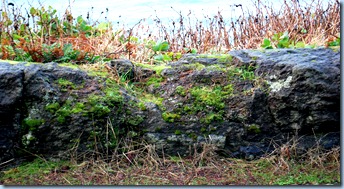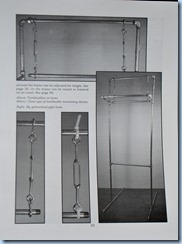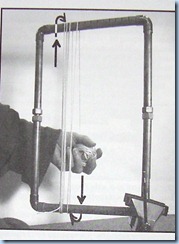Motion is a change in position of an object with respect to time and its reference point.
Motion signifies a continuous change in the configuration of a physical system. vs..
“Entropy is the only quantity in the physical sciences (apart from certain rare interactions in particle
physics;)
that requires a particular direction for time, sometimes called an arrow of time.
As one goes "forward" in time, the second law of thermodynamics says, the entropy of an isolated system will increase.
Loom picture with new work.
Hence, from one perspective, entropy measurement is a way of distinguishing the past from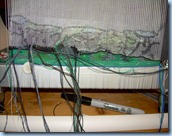 the future
the future
One of the ideas involved in the concept of entropy is that nature tends from order to disorder in isolated systems- or towards possible chaos.
Detail of new piece-not yet named.
I am weaving this is on my new smaller mirrix. It’s the 12 inch.
Perfect with the new regs. on bag sizes-since I need room to get my treadle in the bag also.
Entropy as Time's Arrow
http://hyperphysics.phy-astr.gsu.edu/hbase/therm/entrop.html’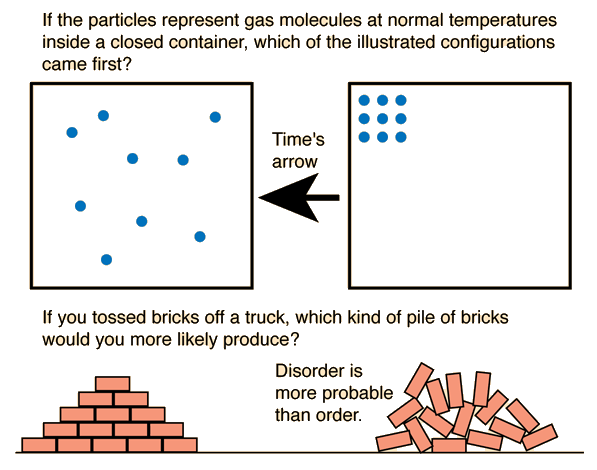
Last time was all about getting started again.
The time the next step is movement or creating motion and avoiding the possible chaos of “times arrow”.
Movement is happening as to which direction the movement is going or if it is just a product of entropies possible chaos is left to be seen. Can never tell with entropy I know that chaos is rampant in the studio and,
of course, it is tax season. Around here that means Spencer is working 9-9/24-7 at Block. Leaving me to try and keep everything organized, flowing and Chaos at bay. The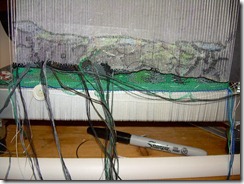 good news and showing movement is the solar goes up on the house Wednesday and the heat pumps should go up on Friday in the studio-warmth. The end of the remodel is nearer. Bad news- I am still clearing out my Dad’s house.
good news and showing movement is the solar goes up on the house Wednesday and the heat pumps should go up on Friday in the studio-warmth. The end of the remodel is nearer. Bad news- I am still clearing out my Dad’s house.
Good News-I have started another piece. It doesn’t have a name yet. But is based on a smaller cartoon that I blew up to 8.5 by 11 inches. I am working on the rock wall that I added to the other cartoon. I have also added a feather as a writing utensil for the lines of the dismembered or incomplete puzzle pieces. I would really like to have this finished by February 24. Yes, of this year! Doable if nothing else interferes.
I finished a small sunset piece that is 1.5 inches by 8.5 inches. Wove four samples for the new book. They are 2 inches by 8-12 inches with the exception of one which is 3/4 inches by 8 inches on value. This tapestry design is from a photo that I took at Christmas at Yachats hanging on the edge of a side of a cliff while trying to get the brush out of the frame. It’s part of a series of 320 photos that I took 20 seconds apart while the sun was going down. Still hoping to photograph a Green Flash. The odds of even seeing one the second time are almost non existent, but I keep trying. This is the first time I am seeing the this direction. It hasn’t been cut from the loom. Feels really strange. I think I may like it better the other direction. The direction I wove it.
The green flash is actually an observable phenomena, Not the Comic book character. I saw a green flash about 15 years ago on the Oregon coast near Yachats, but didn’t get my camera turned on in time.
Cover to Flash Comics #1 (Jan. 1940)
Art by Sheldon Moldoff- DC comics.
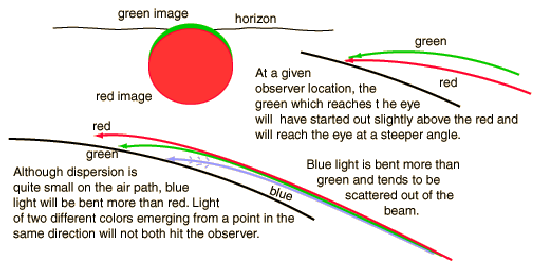 |
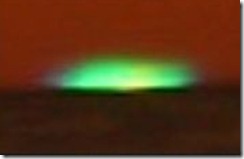
Liberated from Wikipedia photos
My line piece was accepted into The ATA3 small format exhibit. Which has left me slightly bemused after seeing 4 examples from the exhibit that were used for advertising the exhibit j-pegs of several pieces that weren’t accepted. I am not sure how or why my piece is in the exhibit for a dozen different reasons that have nothing to do with the quality of my work. I think I need to see the other 33 or so pieces before I do any real thinking about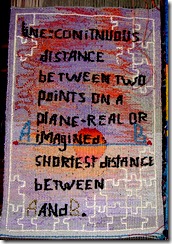 the exhibit. I am rapidly coming to the decision/conclusions that my designs are an anachronism. They just don’t fit anywhere in what’s going on in tapestry at this point in history. I see them almost as pictograph- pictorial narratives as opposed to created objects or sculptural realization of an image. It seems more and more that tapestry artist are moving away from the simple telling of a story in pictures or at least the small format juried shows seem to be. Doesn’t really matter anymore. I know what I want to weave and how I want to weave my images. I know, I know, I have been told everything has it’s on story or narrative. I want mine to read more as Lakota “Winter Counts) like the “doodles” or pictographs my Grandmother kept to remind herself of important things in her life.(see http://wintercounts.si.edu/flashindex.html) This is a great exhibition and explanation of Winter counts
the exhibit. I am rapidly coming to the decision/conclusions that my designs are an anachronism. They just don’t fit anywhere in what’s going on in tapestry at this point in history. I see them almost as pictograph- pictorial narratives as opposed to created objects or sculptural realization of an image. It seems more and more that tapestry artist are moving away from the simple telling of a story in pictures or at least the small format juried shows seem to be. Doesn’t really matter anymore. I know what I want to weave and how I want to weave my images. I know, I know, I have been told everything has it’s on story or narrative. I want mine to read more as Lakota “Winter Counts) like the “doodles” or pictographs my Grandmother kept to remind herself of important things in her life.(see http://wintercounts.si.edu/flashindex.html) This is a great exhibition and explanation of Winter counts
I am really excited about the progress Pat and I are making on the new book. The samples are fun to weave.  Written explanations are a little-okay a lot more more difficult as we combine to very different view points into a cohesive understanding of both.
Written explanations are a little-okay a lot more more difficult as we combine to very different view points into a cohesive understanding of both.
These first two samples/ pictures are depicting what happens when you decide to subtract wefts from the weft bundle. It’s about trying to have more hatches in a given area for finer optical blending in the structural bridge colours of the hatches. The first one with the green was woven from paternayan and started with 4 threads in each weft bundle and moved to 1 thread in the weft bundle. We decided that as a sample it would be too difficult to photograph for the book-not contrasty enough. The second sample was woven with the Norwegian Alv yarns that FFP imports. There were 5 threads in the initial weft bundle. Each section is 1.75 inches tall by 2 inches wide.
This third sample is what happens when you mix a chene’ or mélange with hatches. Again with the alv yarns and at 10 epi. Progression is the same 1 thread off one weft bundle and added to the other weft bundle. One always has 5 threads in the weft bundle. 
The next sample is a value run that I was trying to weave from light value to dark value. It actually begins with white and runs into black. Each square is .75x.75 inches. The first problem that I ran into was there are no achromatic greys. No one company has an even progression from light to dark.So were back to using colour aide papers and preprinted value cards. Greys are usually produced by greying out or mixing a colour such as green or lavender, etc.. with the complement in the dye process. So I am in a quandary as to how to produce or weave an achromatic progression for the optical blending book Pat and I are writing.
As promised, Kay S. Here’s how I sometimes keep from pulling out my cartoon sewing thread and keep from loosing my needle. It involves a button and a knot.
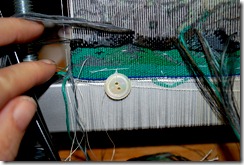
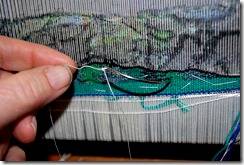 Hopefully you can see that the button is tied to the end of the thread and knotted as is the thread knotted at the base of the eye of my curved needle. The knot is pulled really tightly and is really no thicker then the needle. The knot slips right through the tapestry as I sew the cartoon to the back of my tapestry.
Hopefully you can see that the button is tied to the end of the thread and knotted as is the thread knotted at the base of the eye of my curved needle. The knot is pulled really tightly and is really no thicker then the needle. The knot slips right through the tapestry as I sew the cartoon to the back of my tapestry.
Time to go. Wry made the mistake of using Chene’s water bowl and food dish. Chene’s making sure Wry doesn’t do it again and ignoring the quiet command. Very related to one of my favourite tapestry by Pat Williams.
Next time! Have fun! Weave a lot!
kathe
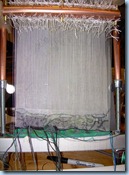

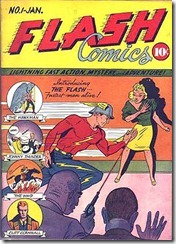


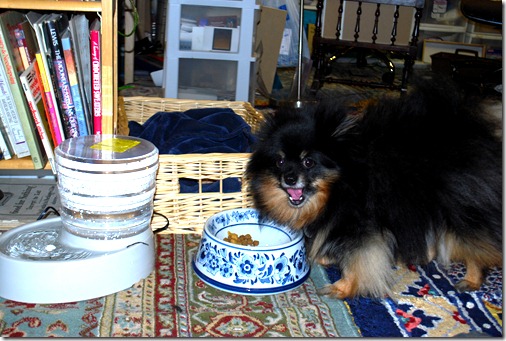
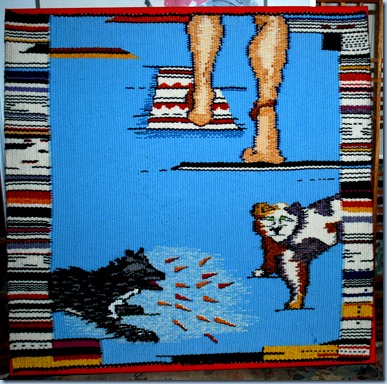
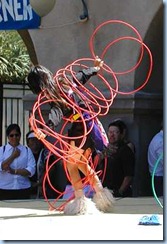

 -tr
-tr
 t
t s)1. Loose fragments, such as sand or gravel, that have been worn away from rock.2. Matter produced by the decay or disintegration of an organic substance.
s)1. Loose fragments, such as sand or gravel, that have been worn away from rock.2. Matter produced by the decay or disintegration of an organic substance.


